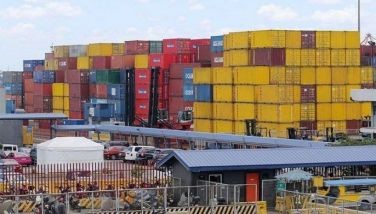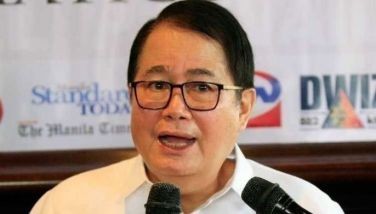Numbers can lie

At the very least, numbers can mislead. For financial statements, accountants call it window dressing. Apparently, the Marcos Central Bank officials had the intention of hiding the CB’s deteriorating numbers.
That was the obvious objective in the “kiting” operation that resulted in an overstatement of the country’s forex reserves. That was also the intention when they created asset accounts that capitalized CB’s losses and deficits.
The biography of Cesar Virata written by Gerardo Sicat explained how CB treasury operations followed the sun to produce a positive net position.
“... foreign exchange operations constituted a round-the-clock affair. Transactions could benefit from the movement of the trading day from east to west, through the main financial capitals of the world: from Hong Kong-Singapore to Frankfurt-London to New York. The aim was for the country’s net position to be sufficiently liquid by the end of the day in New York, where the Central Bank made its payments transactions.”
The embarrassing discovery of CB’s forex overstatement forced them to ask SGV to investigate. SGV produced a confidential report. Our very enterprising Philippine Star business reporter, Iris Gonzales, got hold of a Monetary Board report that contained results of Monetary Board hearings, as well as SGV’s audit report. She wrote about it on May 6, 2019 in this paper’s business section. Here are portions of Iris’s report:
“I spent nights leafing through the report, which was jaw-dropping to say the least. Bloating our dollar reserves was no doubt one of the Philippines’ biggest lies. Here’s what I gathered from the confidential documents:
“1) There were five types of transactions, which all had the effect of overstating the country’s gross international reserves. They were done by Central Bank officials.
“2) The special transactions were done regularly from November 1982 to September 1983 using placements with PNB’s branches overseas. At the time, lenders were tightening credit to the country because of ‘the general nervousness on the economy.’
“3) It was at this point that the Central Bank apparently looked into more imaginative ways of improving the balance of payments and maintaining its reserves position. This gave rise to these so-called special transactions.
“3) Transactions ranged from $500 million to a whopping $1 billion, but these were not funded. They were merely accounting entries.
“4) Another transaction involved the sale by the Central Bank of US dollar treasury bills to PNB Hong Kong amounting to $100 million. No actual delivery happened, but the proceeds were recorded as foreign currency time deposits, thus increasing the international reserves on paper.
“5) In the first quarter of 1983 alone, the Central Bank has had to contend with an average short position of $150 million to $175 million daily.
“6) Said the report: ‘the transactions have been found to be fictitious without any funding, in effect generating non-existent reserves for the Central Bank.’
“This went on for almost a year. How sad and embarrassing it must have been for our country. Imagine we had to lie about our dollar position so we could borrow money from lenders to pay for imports and to fund the grandiose projects of the late dictator Ferdinand Marcos.
“This, while his wife Imelda went on wild shopping sprees around the world. Remember that story about how an airplane that departed Rome had to do a mid-air U turn because the former first lady realized she’d forgotten to buy some cheese?
“Why did Central Bank officials do it? The report concluded that it was a desperate measure for an institution caught in the middle of a liquidity crunch.”
I was covering the Senate when the dissolution of the Central Bank and the creation of the Banko Sentral ng Pilipinas was being debated. Sen. Alberto Romulo delivered a privilege speech (Feb. 3, 1993) that exposed the means by which CB officials were trying to hide the problems created by Marcos and his cronies.
Romulo disclosed a COA report as the basis of his speech: “As of Dec. 31, 1990, Central Bank’s total recorded assets amounted to P 444.89 billion. However, P 280.85 billion or 63.13 percent were without any realizable or economic value…
“With this COA report, the cat, so to speak, is out of the bag… As its liabilities exceed its assets, the Central Bank is an insolvent institution.”
Romulo continued: “Marcos and his technocrats, through Presidential Decree 144 and PD 1937, actually repealed GAAP (Generally Accepted Accounting Principle) to suit their larcenous proclivities and decreed that the Central Bank losses/deficits be capitalized as deferred charges and thereafter amortized on the basis of the bank’s profits… “
The consequence of this Central Bank manipulation, Romulo said, is a national disaster.
In another privilege speech on Feb. 3,1993, Sen Romulo said bank insiders revealed the Marcos family “have charged shopping trips abroad to one of the suspense accounts, either the monetary adjustment account (MAA) or the exchange stabilization account (ESAA).
“How in the world can such a shopping trip be a legitimate charge either to the MAA or the ESAA, which under CB accounting forms part of the assets of the Central Bank?”
It is not just the CB. Sen. Romulo said in a Jan. 20,1992 privilege speech that other financial institutions were gutted and ravaged by the Marcos cronies: the Philippine National Bank (PNB), the Development Bank of the Philippines (DBP), the Government Service Insurance System (GSIS), and the Philippine Veterans Bank (PVB) appeared the most terminally ill.
“So thorough and systematic was the plunder of these institutions that in 1986 and 1987, at least P 209 billion of taxpayers’ money was required to bail them out.”
The major cause of the CB losses, Sen. Romulo said, is the disastrous foreign exchange hedges the bank granted in the 1970s up to 1980 to a privileged group of businesses.
“No matter how the problems are approached, the economic mismanagement of the Marcos regime will continue to dog the country for years to come.”
It is unfortunate that most of the investigation reports are still considered classified. Over 30 years have passed, and these should all be declassified and made available to the public. We need to know how we were screwed.
Boo Chanco’s email address is [email protected]. Follow him on Twitter @boochanco.
- Latest
- Trending



























